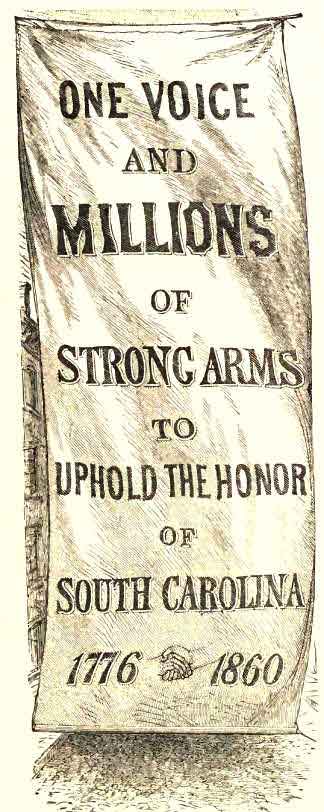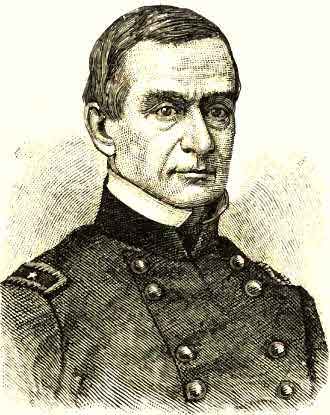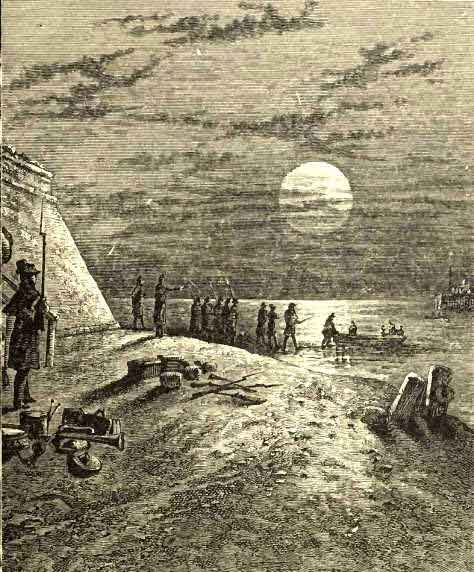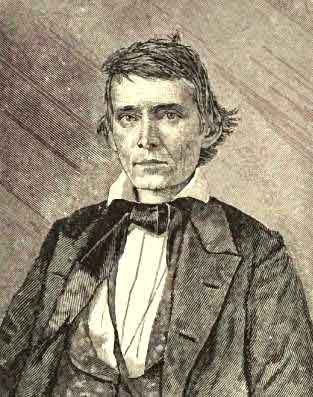1860-1868 Chapter II Secession
CHAPTER II.
SECESSION
Secession was no new thought at the South. It lurked darkly behind the Kentucky and Virginia resolutions of 1798-99. It was brought out into broad daylight by South Carolina in the nullification troubles of 1832. "Texas or disunion!" was the cry at the South in 1843-44. In 1850 South Carolina declared herself ready to secede in the event of legislation hostile to slavery. Two years later the same State solemnly affirmed that it had a right to secede, but that, out of deference to the wishes of the other slave States, it forbore to exercise such right.
VOL. III.--20
It must be admitted that in early years the North had helped to make the thought of secession familiar. In 1803, in view of the great increase of southern territory by the Louisiana Purchase, and again in 1813, when New England opposition to the war with England culminated in the Hartford Convention, there had been talk of a separate northern confederacy. But from that time on the thought of disunion died out at the North, while the South dallied with it more and more boldly. During the presidential campaign of 1856, threats were made that if Fremont, the republican candidate, should be elected, the South would leave the Union. In October of that year a secret convention of southern governors was held at Raleigh, N. C., supposed to have been for the purpose of considering such a contingency. Governor Wise, of Virginia, who called the convention, afterward proclaimed that had Fremont been chosen he would have marched to Washington at the head of 20,000 troops, seized the Capitol, and prevented the inauguration. This threatening attitude in 1856 may have been chiefly an electioneering device; but during the next four years the gulf between North and South widened rapidly, and the southern leaders turned more and more resolutely toward secession as the remedy for their alleged wrongs.
No sooner had the presidential campaign of 1860 begun than deep mutterings foretold the coming storm. "Elect Lincoln, and the South will secede!" cried the campaign orators of the South, while the halls of Congress rang with threats similar in tenor. As the campaign went on and republican success became probable, the southern leaders began to nerve up their hosts for the conflict. In October the governor and congressmen of South Carolina, with other prominent politicians, met and unanimously resolved that if Lincoln should win, the Palmetto State ought to renounce the Union. Similar meetings were held in Georgia, Alabama, Mississippi, and Florida. Governor Gist sent a confidential circular to the governors of all the cotton States declaring that South Carolina would secede with any other State, or would make the plunge alone if others would promise to follow.
The governors of Florida, Alabama, and Mississippi replied that their States would certainly do this. Georgia proposed to wait for some overt act by the National Government. North Carolina and Louisiana, it was learned, would probably not go out at all.
But the enthusiasts in South Carolina had got all the encouragement they wanted, and bided their time. Their time was at hand. The presidential election fell on November 6th. Next day the tidings flashed over the land that Abraham Lincoln had been elected President by the vote of a solid North against a solid South. The wires had scarcely ceased to thrill with this message of death to slavery-extension, when South Carolina sounded a trumpet-call to the South. Her Legislature ordered a secession state convention to meet in December, issued a call for 10,000 volunteers, and voted money for the purchase of arms. Federal office-holders resigned. Judge Magrath, of the United States District Court, laid aside his robes, declaring,
"So far as I am concerned, the temple of Justice raised under the Constitution of the United States is now closed." Militia organized throughout the State. The streets of Charleston echoed nightly with the tramp of drilling minute-men. Secession orators harangued enthusiastic crowds. Hardly a coat but bore a secession cockade. November 17th, the Palmetto flag was unfurled in Charleston. It was a gala day. Cannon roared, bands played the Marseillaise, and processions paraded the streets bearing such mottoes as "Let's Bury the Union's Dead Carcass!" "Death to All Abolitionists!" The whole South was beside itself with excitement. One State after another assembled its convention to decide the question of secession. Even the Georgia Legislature, within a week after the election of Lincoln, voted $1,000,000 to arm the State.
The South Carolina convention met at Charleston, and on December 20th unanimously adopted an ordinance declaring:
"The union now subsisting between South Carolina and other States, under the name of the United States of America, is hereby dissolved."
This action was hailed with wildest enthusiasm. Huge placards--"The Union is Dissolved!"--were posted throughout the city, while the clang of bells and the boom of cannon notified the country round. The sidewalks were thronged with ladies wearing secession bonnets made of cotton with palmetto decorations.
 .
.
Street Banner in Charleston.
"One voice and millions of strong arms to uphold the honor of South Carolina
A party of gentlemen visited the tomb of Calhoun, and there registered their vows to defend the southern cause with their fortunes and lives. In the evening the convention marched to the hall in procession, and formally signed the revolutionary ordinance. The chairman then solemnly proclaimed South Carolina an "independent commonwealth." The little State, whose white population was less than 300,000, began to play at being a nation. The governor was authorized to appoint a cabinet and receive foreign ambassadors, and the papers put information from other parts of the country under the head of "foreign news."
The secession of South Carolina was greeted with joy in most of the other slave States. Montgomery and Mobile, Ala., each fired one hundred guns. At Richmond, Va., a palmetto banner was unfurled, while bells, bonfires, and processions celebrated the event all over the South. The other cotton States, spurred on by the bold deed of South Carolina, rapidly followed her lead. Mississippi seceded January 9th, Florida the 10th, Alabama the 11th, Georgia the 19th, Louisiana the 26th, Texas February 1st.
It is probable that only in South Carolina, Mississippi, and Florida were the majority of whites in favor of secession. The South was after all full of Union sentiment. The ordinance of secession proceeded in each State from a convention, and the election of delegates to this witnessed the earnest work. The noble efforts of those Union men in their fierce struggle have never yet been appreciated. But they fought against great odds, and were inevitably overborne. The opposition was organized, ably led, and white-hot with zeal. The political power and the wealth of the South lay in the hands of the secessionists. The clergy threw their weight on that side, preaching that slavery, God's ordinance, was in danger. Union proclivities were crushed out by force. Vigilance committees were everywhere on the alert.
In the rougher States of the Southwest abolitionists were tarred and feathered. Some were shot. In all the States Union men were warned to keep quiet or leave the South. One of the most powerful agents of intimidation was the Knights of the Golden Circle, a vast secret society which extended throughout the southern States.
Yet, in spite of all, the vote was close even in several of the cotton States. The Georgia people wanted new safeguards for slavery, but did not at first desire secession. Alexander H. Stephens, who headed the anti-secession movement, declared that Georgia was won over to take the fatal step at last only by the cry, "Better terms can be made out of the Union than in it." Even then the first vote for secession stood only 165 to 130. In Louisiana the popular vote for convention delegates was 20,000 for secession and 17,000 against.
The border States held aloof. Kentucky and Tennessee refused to call conventions. So, for long, did North Carolina. The convention of Virginia and of Missouri each had a majority of Union delegates. When the Confederate Government was organized in February, only seven of the fifteen slave States had seceded. Their white population was about 2,600,000, or less than half that of the entire slave region. But Arkansas and North Carolina were soon swept along by the current, and seceded in May. Virginia and Tennessee were finally carried (the former in May, the latter in June) by the aid of troops, who swarmed in from the seceded States, and turned the elections into a farce. Unionists in the Virginia Convention were given the choice to vote secession, leave, or be hanged. Missouri, Kentucky, Delaware, and Maryland resisted all attempts to drag them into the Confederacy, though the first two, after the United States began to apply force, appeared neutral rather than loyal.
The seizure of United States property went hand in hand with secession. Most of the government works were feebly garrisoned, and made no resistance. By January 15th the secessionists had possession of arsenals at Augusta, Ga., Mount Vernon, Ala., Fayetteville, N. C, Chattahoochee, Fla., and Baton Rouge, La., of forts in Alabama and Georgia, of a navy-yard at Pensacola, Fla., and of Forts Jackson and St. Philip, commanding the mouth of the Mississippi.
SECESSION 315

Major Robert Anderson.
At one arsenal they found 150,000 pounds of powder, at another 22,000 muskets and rifles, besides ammunition and cannon, at another 50,000 small arms and 20 heavy guns. The whole South had been well supplied with military stores by the enterprising foresight of J. B. Floyd, of Virginia, Buchanan's Secretary of War, who had sent thither 115,000 muskets from the Springfield arsenal alone.
Fort Moultrie, in Charleston harbor, was held by Major Robert Anderson, of Kentucky, with a garrison of some seventy men. On December 27th the whole country was thrilled, and the South enraged, by the news that on the previous night Anderson had secretly transferred his whole force to Fort Sumter, a new and stronger work in the centre of the harbor, leaving spiked cannon and burning gun-carriages behind him at Moultrie. The South Carolina militia at once occupied the deserted fortress with the other harbor fortifications, and began to put them into a state of defence. At Pensacola, Fla., Lieutenant Slemmer, by a movement similar to Anderson's, held Fort Pickens.

Major Anderson removing his Forces from Fort Moultrie to Fort Sumter,
December 26, 1861.
The seizure of government property went on through January and February. In Louisiana all the commissary stores were confiscated, and the revenue cutter McClelland surrendered. The mint at New Orleans, containing over half a million in gold and silver, was seized. More than half of the regular army were stationed in Texas, under General Twiggs. In February, at the demand of a secessionist committee of public safety, he surrendered his entire force, together with eighteen military posts. The troops were sent to a Gulf port and there detained.
This wholesale seizure of government property, worth some $20,000,000, has brought down upon the South much scathing rebuke. The conduct of Floyd, stabbing his country under the cloak of a cabinet office, cannot be too strongly condemned; but with the seceding States the case was different. Having (so they thought) established themselves as independent republics, they could not allow the military works within their borders to remain in the hands of a foreign power. As to the Government's property right, they recognized it, and proposed to pay damages. The provisional constitution of the Confederacy, adopted in February, provided for negotiations to settle the claim of the United States.
SECESSION 319
The southern leaders were not more anxious to get the slave States out of the Union than to get them into a grand Southern Confederacy. Early in January a caucus of secession congressmen was held at Washington, and arrangements made for a constitutional convention.
February 4, 1861, delegates from the States which had left the Union met at Montgomery, Ala., and formed themselves into a provisional Congress. A temporary government, styled "The Confederate States of America," was soon organized. Jefferson Davis, of Mississippi, was chosen President by the Congress, and Alexander H. Stephens, of Georgia, Vice-President. Davis was born in Kentucky in 1808. He graduated at West Point, fought as colonel in the Mexican war, served three terms as congressman from Mississippi, the last two in the Senate, and was Secretary of War under Pierce. After Calhoun's death, in 1850, he became the most prominent of the ultra southern leaders. The new President was brought from Jackson, Miss., to Montgomery by a special train, his progress a continual ovation.

Jefferson Davis.
Cheering crowds gathered at every station to see and hear him. February 18th Davis was inaugurated. In his address, which was calm and moderate in tone, he declared that reunion was now "neither practicable nor desirable;" he hoped for peace, but said that if the North refused this, the South must appeal to arms, secure in the blessing of God on a just cause.
The Confederate President was intrusted with very large powers, including supreme control of military affairs. He was authorized to muster into the service of the central government the regiments which had been forming in the various States. A call was issued for 100,000 volunteers, and provision made for organizing a regular army. President Davis appointed a cabinet, with state, treasury, war, navy, and post-office departments. Robert Toombs, of Georgia, a rabid secessionist, became Secretary of State.
March 11th the Confederate Congress adopted a permanent constitution. It reproduced that of the United States, with some important changes. State sovereignty was recognized in the preamble, which read, "We, the people of the Confederate States, each State acting in its sovereign and independent character," etc. Slavery was called by name, and elaborate safeguards fixed for it in the States and Territories.
VOL. III.--21

Alexander H. Stephens.
Slave-trade from beyond the sea, or with states not in the Confederacy, was, however, prohibited. Protective tariffs were absolutely forbidden. The president and vice-president were to serve six years, and the former could not be re-elected.
Some valuable features were inserted. Members of the cabinet might discuss matters pertaining to their departments in either house of congress. The president could veto one part of an appropriation bill without killing the whole, and was required to lay before the senate his reasons for the removal of any officers from the civil service.
By the last of April all the seceded States had ratified this constitution. The other slave States were taken in as fast as they withdrew from the Union. The Southern Confederacy, now fairly launched, set sail over strange seas upon its short but eventful voyage. At the start the hopes of those it bore rose high. Few believed that the North would dare draw sword. Even if it should, the southern heart, proud and brave, felt sure of victory. King Cotton would win Europe to their side. Peace would come soon. Visions of a glorious future dazzled the imaginative mind of the South.
324 CIVIL WAR AND RECONSTRUCTION
A vast slave empire, founded on the "great physical, philosophical, and moral truth" that slavery is the "natural condition," of the inferior black race, would spread encircling arms around the Great Gulf, swallowing up the feeble states of Mexico, and rise to a wealth and glory unparalleled in the history of nations.


